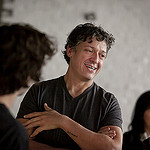Nestor Gil

Art
Q: What motivated you to apply for an information literacy grant for ART206 Materials and Methods?
A: My main motivation came from seeing how students often practiced studio art in a vacuum. Studio art is not just about making pretty images or forms. It is another way to investigate the world using visual media. Artists and their works are filters through which realities are reconsidered and reconstructed. I wanted students to connect what they were doing in the studio with what was going on in the art world and beyond.
Q: How did you come up with the assignments? How was your class structured?
A: Kelly Smith, Visual Resources Librarian, and Lijuan Xu, Instruction Coordinator, helped me frame the research assignments. There were three main projects, including performance art, book(s as) art, and body. Before producing their own studio work in each area, students researched an artist of their choice and posted images of the artist’s work to the class blog. They reported on their artists and artwork during class and explained how they identified the artists and found the images. After presenting their own creative work to the class, students had to find and research an artist whose work resonated with theirs and share that with the class. At the end of the semester, students gave a PechaKucha style presentation (10 slides with 20 second intervals) in which they summarized and reflected on their research and art making experience.
Q: You devoted most of each Thursday’s class to IL. Were you concerned that you might not be able to cover enough content?
A: There is always a lot of content to cover but there is also teaching students how to learn, which was a big part of the class. Although I did not cover a lot of content, having students do research and share their findings with their peers created a wealth of information. Students presented a wide range of artists and artworks including some I would not have done myself. Seeing what other artists were doing also inspired students and gave them permission to take risks, which made their own studio works far more powerful and interesting.
Q: Kelly and Lijuan did several library sessions including one on copyright and fair use. How did they go?
A: Kelly and Lijuan did a great job preparing students with strategies and resources needed for the research projects. Their participation in the class throughout the semester was also crucial since they were able to address any research question or need as it rose. For all three projects, instead of going to Google and randomly selecting an image for the blog, students used what was available in the library to learn about artists and what they were known for. They also pursued what sparked their interest. Some students presented artists whom they did not like but they found the stories too compelling and others ended up researching on artists that they came across while reading about another.
The relationship between artists and copyright is often times contentious since artists very often appropriate images, ideas, and forms to produce their own works. I am not an expert in this area so I was happy to rely on Kelly and Lijuan. After a brief introduction to copyright and fair use, students were divided into two groups to debate on a recent copyright case. They had fun with it. It was an interesting and important conversation to have so students had a better understanding of what copyright and fair use meant and how to navigate these areas while they are at Lafayette and after they graduate.
Q: Do you have any advice for faculty who are interested in building IL into their classes?
A: My advice is the same as Brett Hendrickson’s: just do it. And talk to research librarians about it. They can help you figure out whether there is a place for IL in your classes and how IL can be integrated.
Q: What was your understanding of IL? How did it differ after ART 206?
A: IL means knowing where and how to find information and understanding how our own creative works fit within a larger conversation. After ART206, I have a much broader or more three dimensional sense of IL. It is much more than just how to use the library to discover things about the art. It has a lot more to do with helping students become independent and lifelong learners.
Q: Would you continue to incorporate IL into future versions of this course or other courses?
A: Absolutely. Having built IL into ART206 and having seen the result of it, I do not see how I can go back to my old way of teaching. I will model all my studio classes after ART 206 by requiring students to research on artists and share with the class what they have learned as a regular part of the class.
Q: What do you think professors and librarians could do to help students develop their critical thinking and IL skills?
A: Find ways to require students to take responsibility for their own learning. The formats and assignments differ depending on the class. For ART 206, it took the form of student driven research, presentations, blog and research journals. Make IL a regular part of the class. I do not think having a couple IL sessions at the beginning of the semester is effective. Once students have done something like that with two or three classes, they pay less attention each time. However, when it is fully integrated, they cannot write it off.